Push ups are one of the most effective bodyweight exercises for building a bigger, stronger chest. Push-ups also work a variety of other muscle groups, including the triceps, shoulders, core, and back.
Push-ups can be performed, regardless of where you are and, best of all, they are completely free, no expensive equipment or annual gym fees required.
The chest push-up and other variations of the push-up are effective exercises for both novices and athletes. You don’t need any special equipment to do them.
In this guide, we will cover everything you need to know about push-ups for the chest, including:
- How to do a push-up properly
- Different push-up variations that target different areas of the chest
- How to create a push-up routine for chest
- Tips and proper Form
- Common push-up mistakes to avoid
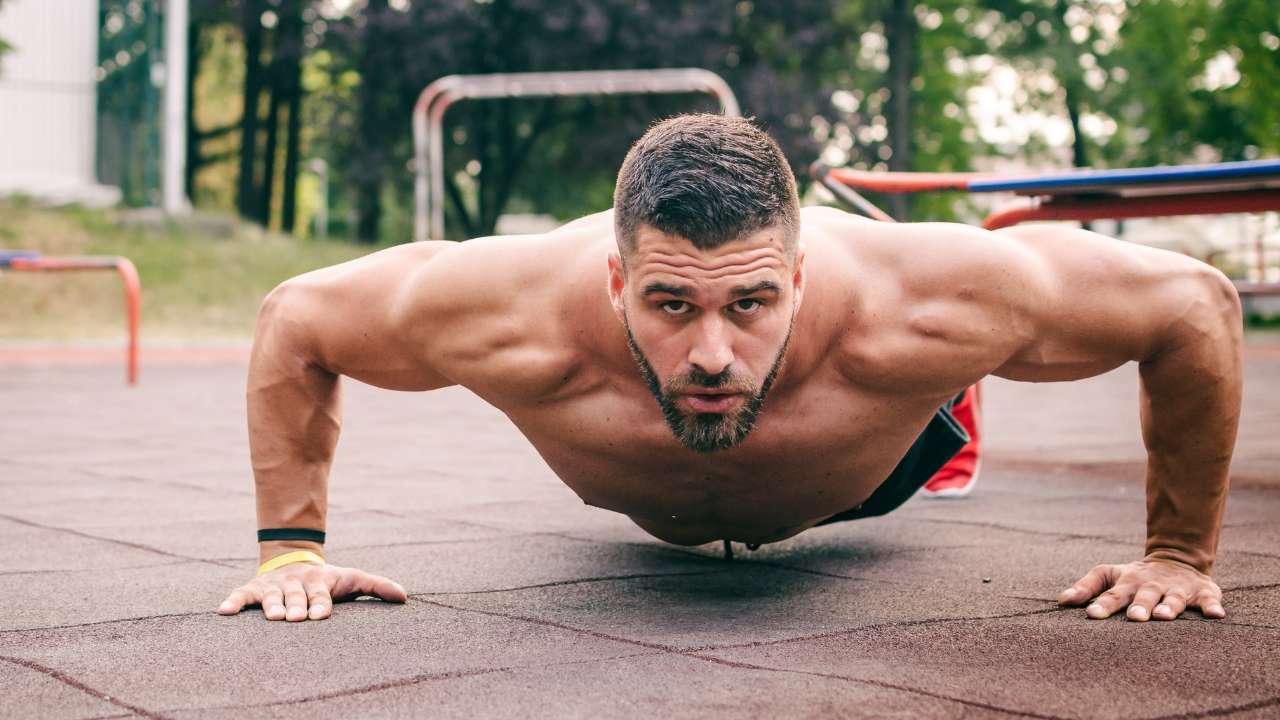
- How To Train Chest With Push Ups
- Push Ups For Chest Growth and Strength
- Make Chest Push Up Easier Or Harder
- Make It Easier
- Make It Harder
- Beginner Push Ups For Chest Growth
- 1. Wall Push Up
- 2. Knee Push-Up
- 3. Incline Push-Up
- Intermediate Chest Ups
- 4. Standard Push-Ups
- 5. Knuckle Push-Up
- 6. Stability Ball Chest Push Up
- 7. Wide Push Up
- 8. Dumbbell Push-Up
- Advance Chest Ups To Build Mass and Strength
- 9. Decline Push-Up
- 10. Feet On Stability Ball Push-Up
- 11. Weighted Chest Push-Up
- 12. Fingertip Push Up
- 13. Single-Leg Push Up
- 14. One Arm Push-Up
- 15. Clapping Push-Up
- Takeaways
- People Also Asks
- Can you grow a chest with push ups?
- Which push ups are best for chest?
- How many pushups a day is good?
- References
How To Train Chest With Push Ups
There are many different ways to do push-ups to work different regions of the chest muscles. Many biomechanical variations of the Push-up exercise can be performed to alter muscle activity by providing either a lesser or greater challenge to the target chest muscle.
The various types of push-ups involve varying hand and foot positions, which affects the muscle recruitment patterns.
That is why some types of push-ups focus on the upper chest, some on the lower chest, some on the triceps, and others on the shoulders.
- The standard push-up has survived the test of time and is the single most efficient exercise to simultaneously strengthen the chest, arms, deltoid, lower back, abs and glutes.
- Incline chest push-ups are easier than compared to the normal push-ups ones because of the angle at which the exercise has to be done. The incline surface means that more of the lower chest, shoulder muscles, tricep are used. It’s the best choice for beginners.
- The decline chest push-up is a more advanced version of the standard push-ups due to the angle at which the exercise must be performed. The decline position means that more of the upper chest, shoulder muscles, tricep are used in decline chest push-ups.
- A simple way to target the inner chest with a push up is to narrow your hand spacing. Close grip push-ups can be used to build the inner chest.
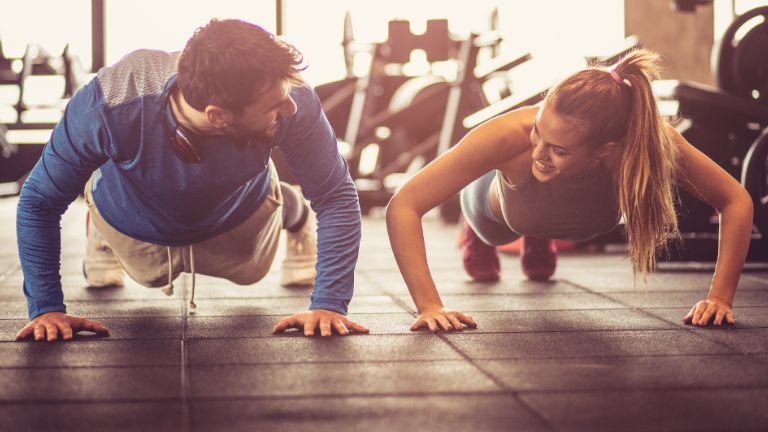
Push Ups For Chest Growth and Strength
Push ups are a great exercise for building strength, endurance, and muscle size in your chest, front shoulders, and triceps. When done with proper form, they activate and challenge all the major muscle groups of the upper body.
Push ups are great because they can be scaled and progressed to challenge your muscles as you get stronger.
If you’re a beginner, intermediate, or advanced lifter, there are many ways to do push ups that work your muscles and make you stronger. Choose the one you like and start exercising.
The chest push ups exercises have been divided into several sections, such as
- Chest push ups for beginners
- Intermediate Chest Push ups
- Advance Push ups
Let’s start with the best push-up exercises for boosting strength and building a big chest.
Make Chest Push Up Easier Or Harder
Modifications can make many of these push-ups easier or harder, but not every modification will work with every push-up.
Make It Easier
- Knees: Perform push-ups on your knees instead of your feet to ease the difficulty on your upper body. This is a great way to build up to more difficult variations.
- Incline: Elevate your hands on a bench, chair, or table—the higher above your feet, the easier.
Make It Harder
- Unilateral: Cross one ankle over the other, so only one foot is on the ground. This requires more core activation for stability.
- Decline: Elevate your feet on a box, bench to increase the activation of the upper chest muscles and the front of the shoulders (anterior deltoids). The higher your feet, the more difficult.
- Weighted: Have a friend place a weight plate on your back for an added strength challenge.
- Plyometric Combinations: Transition between different types of push-ups. For example, go back and forth between narrow and wide hands or the fore and after positions of staggered hands. Get creative.
Beginner Push Ups For Chest Growth
There are endless ways to modify chest push-ups for your specific needs. A guide to the classic push-up and our favorite variations, in more or less ascending order of difficulty.
Here are the best type of chest push-ups variation for beginner, Intermediate and Advance. This will help you to build a strong upper body.
1. Wall Push Up
The wall push-up is a simple and easy type of push-up that dramatically reduces the pressure on the arms, upper back, and abs.
It is a good choice for beginners or for those who are just starting out with strength training.
The closer you are to the wall, the easier it is to do this chest push-up. But remember that you still need to keep your body aligned when you do it.
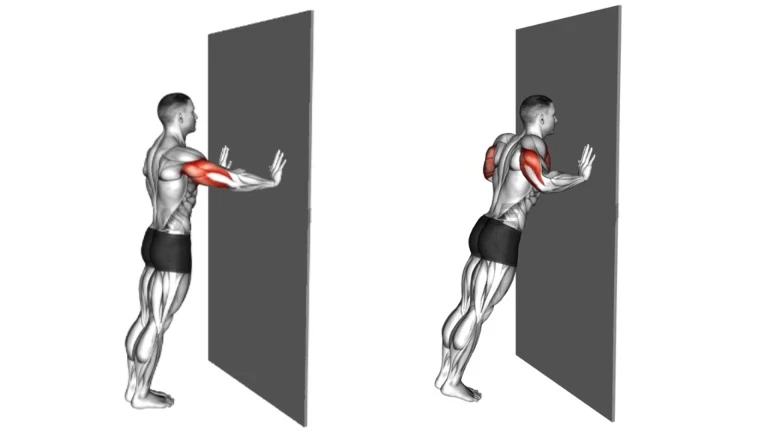
How To Do Wall Push-Ups
- Stand approximately 2 to 2.5 feet away from the wall with your arms held at shoulder height in front of you.
- Place your hands against the wall with your body straight and your legs a few feet behind.
- Lean your body forward so that your elbows flex and your chest comes within inches of the wall.
- Using your hands, push your body back into a standing position.
Training Tips
- The movement should be smooth and controlled.
- Try not to flare your elbows to the sides.
2. Knee Push-Up
The knee push-up, also known as a modified type push-ups, are a great way to strengthen your chest muscles and train your shoulder and triceps.
The knee push-up is a brilliant chest exercise for beginners. If you’re having trouble performing a full push-up, practice an easier push-up variation, the knee push-up.

How To Do Knee Push Up
- Kneel on the floor. Extend arms and put hands shoulder-width apart on the floor in front of you.
- To lower yourself, bend your elbows and bring your chest to the floor.
- Make sure your body is straight from your head to your knees.
- Raise your body to the starting position by pushing up with your arms.
- Repeat the desired number of repetitions.
Training Tips
- Keep your chest active when you go down to the floor.
- Make sure your back is always straight, never slumped.
- Tighten your abs and butt to work your core during push-ups.
3. Incline Push-Up
The incline chest push up is a great bodyweight exercise that you can do to build your chest. It offers numerous benefits and is perfectly suited for both beginners and experienced athletes looking to build upper body strength.
The incline push up for chest is a variation of the push-up where you push yourself off from a raised object instead of the ground.
You can also use objects like a chair, a gym bench, a sofa, a box, a sturdy table, or anything else.
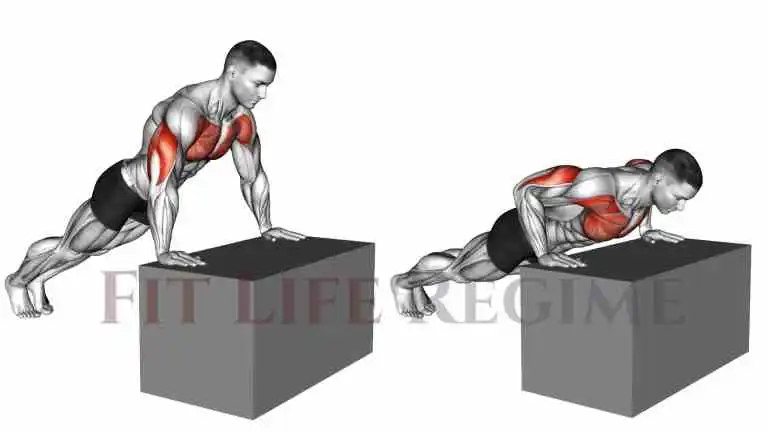
How To Do Incline Push-Up
- Reach forward and grab the sides of the chair or in front of the bench. Keep your feet on the ground.
- Keep your body straight from head to ankle.
- Slowly lower yourself by flexing your elbows so that your chest is close to the edge of the chair or bench.
- Using your hands, push yourself back to the starting position.
- The movement should be smooth and controlled.
Training Tips
- Be sure the bench or chair is stable and secure before you perform the push-ups.
- Your back and legs should be straight at all times.
Intermediate Chest Ups
If you have mastered the beginner push-up, it is time to push yourself with intermediate chest push-ups. These variations are more difficult and will help you build even more strength and muscle mass in your chest.
4. Standard Push-Ups
Standard push up workout is the popular type of push-ups that to build your entire upper body, shoulders, chest, and arms.
Check how to do them correctly and blast your muscles at home or at the gym. This workout must be included in your push-ups’ arsenal.

How To Do Standard Push-Ups For Chest
- Lay face down on the ground with your legs straight and arms supporting your upper body.
- Raise yourself off the ground, straightening your elbows and your arms.
- Raise until your elbows are locked, and pause for a moment at the top of the movement.
- Now lower your body slowly and steadily until your chest is close to the ground.
Training Tips
- Keep your elbows close to your body.
- For additional variations, you can do incline chest push-ups and decline push-ups.
5. Knuckle Push-Up
If you experience pain in your wrists while doing standard chest push-ups, doing push-ups on your knuckles may be a good way to get the benefits without the wrist pain.
The knuckle push up is an advanced exercise that requires extra strength and stability, but can offer powerful rewards for those who master this challenging workout.
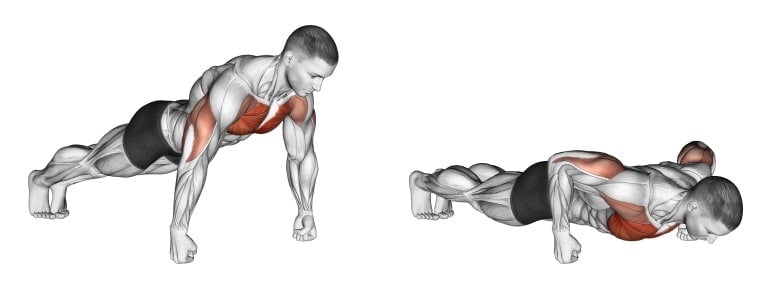
How To Do Knuckle Push Ups
- Start in a plank position with your hands in a closed fist position and your knuckles facing the ground.
- Keep your elbows close to your sides as you lower your body towards the ground.
- Your chest should come close to touching the ground.
- Push back up to the starting position.
- Repeat for the desired number of reps.
Training Tips
- Perform on an exercise mat to avoid any discomfort on your hands.
- Keep your back, shoulders, and feet in a straight line.
6. Stability Ball Chest Push Up
Using a Swiss ball will provide you with an uneven surface to increase the difficulty.
You’ll have to focus on maintaining your balance on the ball, which allows you to work more than you would be performing the standard, floor-bound version of the classic move.

How To Do Stability Ball Push-Ups
- Lay with your chest on the stability ball. Place your hands on the ball at the sides of your chest.
- Place feet back and lean forward so that your chest is directly over the ball, and you are supported on your toes.
- Push your body up, until your arms are almost straight (do not lock your elbows). Pause here for a second.
- Breathe out and extend your arms to bring your upper body back to starting position.
Training Tips
- Do not let your lower back sag or your butt rise. Ensure your body is straight and rigid.
- Your neck should be in line with your body, not tilted up, which could strain the neck.
7. Wide Push Up
If you are capable of performing regular pushups, and you wish to target your muscles differently, wide pushups are a good option.
Wide grip push-ups provide all the benefits of a normal push-up, with a special focus on shoulder and outer chest.

How To Do Wide Chest Push Ups
- Lay face down on the ground with your legs straight, and arms supporting your upper body.
- Put your arms in the 90/90 push up position.
- Slowly go down to the floor.
- Descend until your arms are parallel to the floor.
- Try to return to the starting point by extending your elbows and driving your palms into the floor.
Training Tips
- Remember to keep your back straight with your abs and glutes contracted at all times.
- Keep your chin down and don’t look forward.
8. Dumbbell Push-Up
Dumbbell for push-ups makes push-ups a more powerful exercise and helps you increase upper body strength, muscle mass, and overall balance.
Dumbbell push ups target the same muscle groups as regular push ups, including the chest, triceps, and shoulders, but they can also provide an additional challenge by requiring additional stability and balance.
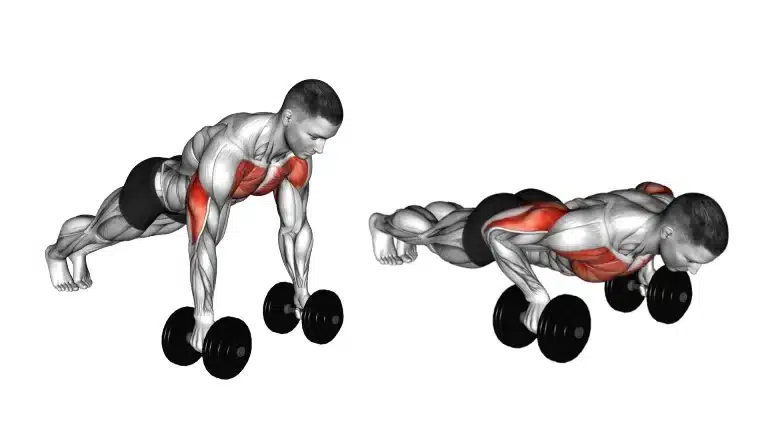
How To Do Dumbbell Push-Ups
- Grip a dumbbell in each hand and get into a plank position with your palms facing down towards the floor.
- Now lift yourself off the ground and straighten your elbows and arms. Keep your elbows close to your body.
- Raise until your elbows are locked, and pause for a moment at the top of the movement.
- Now slowly lower your body until your chest is close to the ground.
Advance Chest Ups To Build Mass and Strength
You’ve built a good foundation of chest strength. Now it’s time to introduce hardcore advanced push up variations that will ignite new muscle growth and power.
These intense techniques will strengthen your chest, shoulders, and triceps, while also improving balance and coordination. Prepare to take your push up game to new heights
9. Decline Push-Up
Decline chest push-ups are the same as normal push-ups, but with your legs on a bench. Even though this push-up is called the decline push-up, it focuses more on the upper chest.
Furthermore, since your lower body is raised from the floor, the resistance your body encounters is increased compared to doing the push-up on the floor. This makes the decline push-up harder than the standard push-up.
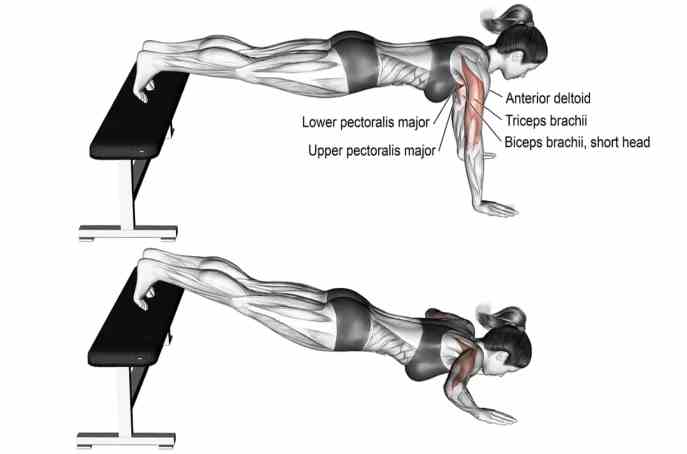
How To Do Decline Chest Push Ups
- Placed your hands firmly on the floor and spaced slightly wider than shoulder-width apart.
- Put legs on the bench or the pad roller.
- Now raise yourself off the ground, straightening your elbows and your arms. Keep your elbows close to your body.
- Raise until your elbows are almost near to locked, and pause for a moment at the top of the movement.
- Now lower your body slowly and steadily until your chest is near the ground.
Training Tips
- Exhale while you exert.
- Vary the position of the bench to hit different angles of the upper chest.
10. Feet On Stability Ball Push-Up
The push-up with feet on a Swiss ball is a progression of the decline push-up that targets the upper chest, shoulders, and triceps while engaging the core.

How To Do Feet On Stability Ball Push-Ups
- Lie face-down on the ball with your arms supporting you in push-up position.
- Roll forward until your pelvis and thighs are off the ball and positioned your feet on top of the ball.
- Your hands should be directly beneath your shoulders.
- Breathe in as you lower yourself by bending your arms until your elbows form a 90-degree angle.
- Pause for one to two seconds at the bottom before breathing out and using your arms to push you up to the starting position.
Training Tips
- Core tight and your back flat throughout the movement.
- Keep your body in a straight line. Don’t allow your hips to sag or rise.
11. Weighted Chest Push-Up
Weighted chest push-ups are a great way to add resistance to your chest workouts and build strength and muscle mass more quickly
The practice of weighted push-ups can have numerous benefits, such as a massive chest, stronger core, and stronger arms. They can also improve testosterone naturally, which transforms the body into a fat-burning furnace.
Start with a small weight plate and work your way up.
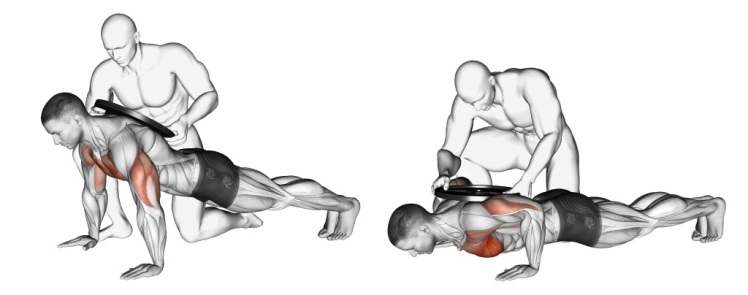
How To Do Weighted Push Ups
- Get in the standard push-up position. Have a partner load a weight plate onto your back.
- Keeping your core tight, slowly lower your body to the ground.
- Make sure to keep your elbows tucked in close by your sides, so they make a 45-degree angle with your torso.
- Once your chest touches the ground, pause, then press back up to the starting position.
- Have your partner remove the plate at the end of the set
12. Fingertip Push Up
Doing push-ups on your fingertips can look impressive, and it’s also an efficient exercise to increase your grip for basketball, bodybuilding, or rock climbing.
It also keeps your wrists straight, making it an excellent way to eliminate wrist pain from the 90-degree bend when your palms are flat on the floor.

How To Do Fingertip Push-Ups
- To assume a standard push-up position, your fingertips are in contact with the ground.
- Breathe in as you lower your torso to the ground until your chest is an inch or two from the ground.
- Keep your elbows close to your body.
- Breathe out as you push yourself up using your arms.
- Think of raising yourself by attempting to push the ground away from you.
Training Tips
- Spread your fingers apart slightly for balance
- Perform on an exercise mat to avoid any discomfort on your fingers.
13. Single-Leg Push Up
The single-leg push-up is one of the most advanced variations of the chest push-up.
The only possible way to complete this movement is with proper stability from your feet up through to your head.

How To Do Single Leg Push-Ups
- Assume a standard push-up position, but place one foot on top of the other or one place one foot in the air straight behind you.
- Lower yourself by bending your elbows. Make sure your chest is close to the floor and your body is straight from head to toe. Lift one leg up in the air.
- Raise your body to the starting position by pushing up with your arms.
- Repeat the desired number of repetitions.
- Make sure to alternate legs in between sets or repetitions to create a symmetrical body.
Training Tips
- To preserve shoulder health, keep your elbows slightly tucked into your body.
- Your neck should be in neutral alignment with the head in a straight line with the spine, from the top of your head to the feet.
14. One Arm Push-Up
A one-arm push-up is a compound exercise that requires far more strength and balance than a standard push-up using two arms.
It just might be one of the most difficult bodyweight exercises to master.
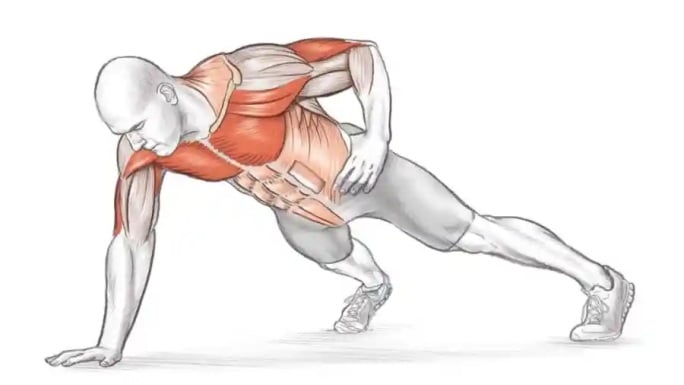
How To Do One Arm Push-Ups
- Get in the standard push-up position. Place one hand on the ground directly beneath your chest and the other behind your lower back.
- To maintain balance, turn your torso slightly away from the pushing arm.
- Breathe in as you lower your angled torso to the ground until your chin is a few inches above the floor.
- Breathe out as you push yourself up from the floor.
- Stop just before you lock out your elbow at the top of the movement.
Training Tips
- Do not rotate your arm outwards from your chest, as it will put additional stress on the elbow that can lead to discomfort and injury.
15. Clapping Push-Up
Clapping Push-ups is an advanced type of chest push-ups exercise that works your chest, triceps, abs, and shoulders.
It can help burn fat and build muscle. Many athletes perform them to help improve their athletic performance by building strength, endurance, and speed.
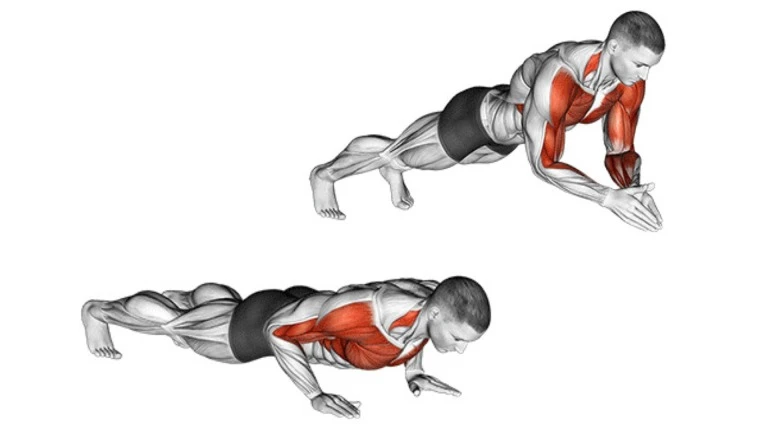
How To Do Clapping Push Ups
- Start in a standard Push-Ups.
- Start to lower your body as if you’re going to do a push until your chest is almost touching the floor.
- Reverse the motion by pushing hard through the palms, just as your arms reach full extension, pull your hands up off the floor.
- Rapidly clapping the hands together and placing them back in the original position before your body falls back to the ground.
Training Tips
- Be sure to exhale when exploding off the ground and inhaling on the way down.
- Do not let the elbows flare out. Keep the elbows close to your sides throughout.
- Keep the core tight and back flat throughout the movement.
Takeaways
If you want to build upper body muscles and gain strength, then you should try different types of chest push-ups.
It not only helps build muscles, but also improves overall fitness. It is a simple task that doesn’t require any further scientific details. If you do it regularly, the results will speak for themselves.
People Also Asks
Can you grow a chest with push ups?
There are many different types of push ups that help to grow the chest, shoulder, and tricep muscles. Push-ups are often changed by changing the hand and foot positions. That is why some types of push-ups focus on the upper chest, some on the lower chest, some on the triceps, and others on the shoulders.
Which push ups are best for chest?
The standard push up is one of the best exercises for the chest. The standard push-up has survived the test of time and is the single most efficient exercise to simultaneously strengthen the chest, arms, deltoid. Incline Push Up works your lower chest. On the other hand, the decline push-up works the upper chest and front shoulders more than the regular or incline variation.
How many pushups a day is good?
There’s no limit to how many push-ups you can do in a day. Many people do more than 200 push-ups a day. For an average person, even 50 to 100 push-ups should be enough to maintain a good upper body.
The number of push ups you do per day depends on your fitness level.
- If you are a beginner, you should start by doing push-ups on your knees or incline push-ups. I recommend doing 10-20 push up a day. But do not stick to this number. It is important to keep increasing the number to challenge your body.
- If you are an intermediate, you should start by doing standard Push-Ups. I recommend doing 50-100 push up a day.
References
- Behm D.G., Anderson K., Curnew R.S. (2002) Muscle force and activation under stable and unstable conditions. Journal of Strength and Conditioning Research 16(3): 416-422.
- Calatayud J., Borreani S., Colado J.C., Martin F., Rogers M.E. (2014) Muscle activity levels in upper-body push exercises with different loads and stability conditions. Physician and Sportsmedicine 42, 106-119.
- Clemons J. (2019) Construct validity of two different methods of scoring and performing push-ups. Journal of Strength & Conditioning Research 33, 2971-2980.
- Chulvi‐Medrano I, Martínez‐Ballester E, Masiá‐Tortosa L. Comparison of the Effects of an Eight‐Week Push‐Up Program Using Stable Versus Unstable Surfaces. International journal of sports physical therapy. 2012 Dec;7(6):586.Available: https://www.ncbi.nlm.nih.gov/pmc/articles/PMC3537455/ (accessed 16.11.2021)
- Cogley RM, Archambault TA, Fibeger JF, Koverman MM. Comparison of muscle activation using various hand positions during the push-up exercise. Journal of strength and conditioning research. 2005 Aug 1;19(3):628.

Manish brings over 10 years of hands-on experience in weight lifting and fat loss to fitness coaching. He specializes in gym-based training and has a lot of knowledge about exercise, lifting technique, biomechanics, and more.
Through “Fit Life Regime,” he generously shares the insights he’s gained over a decade in the field. His goal is to equip others with the knowledge to start their own fitness journey.
